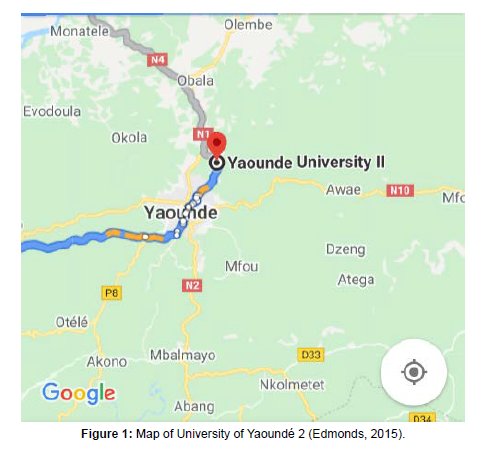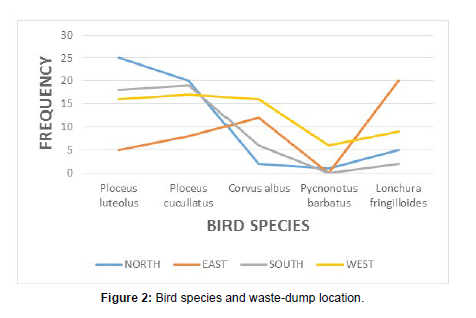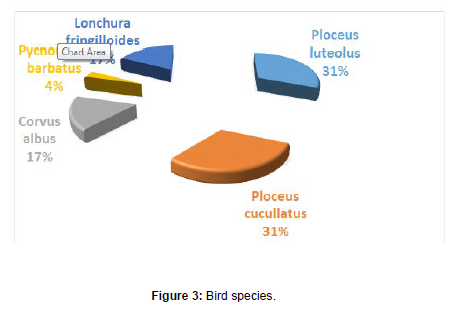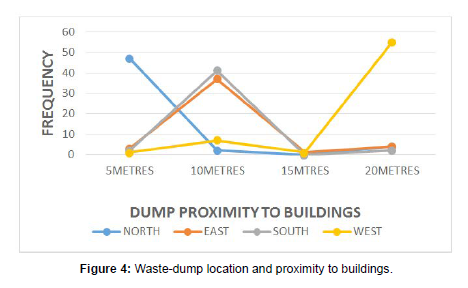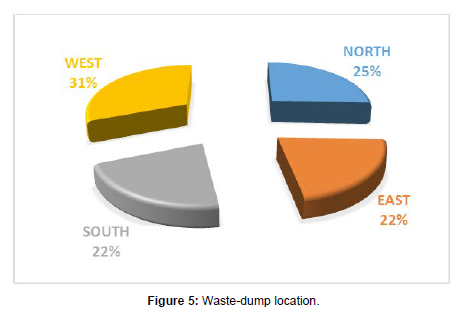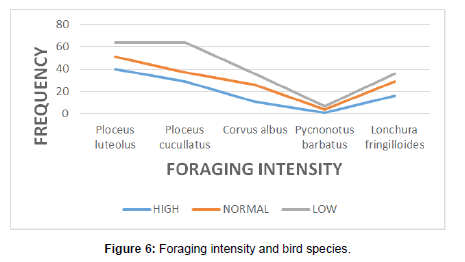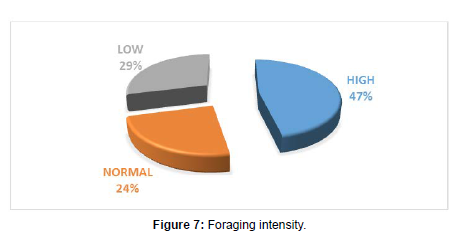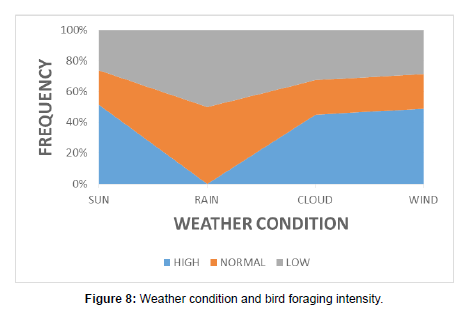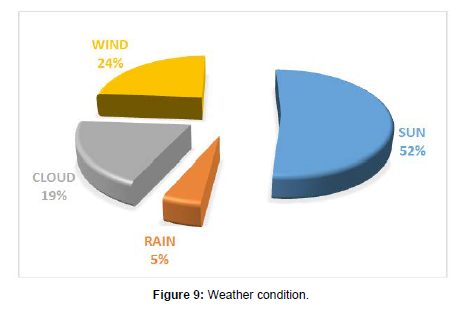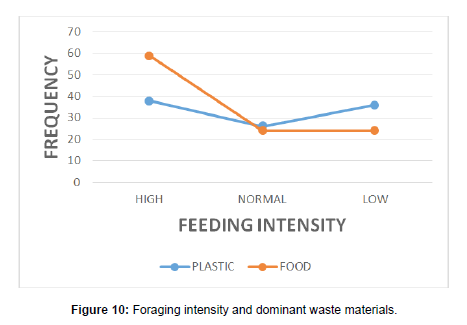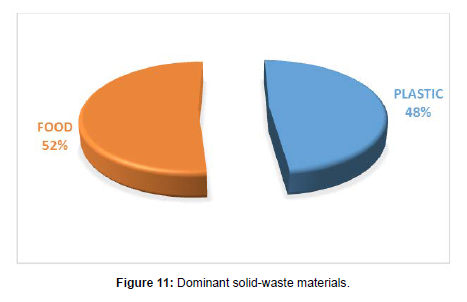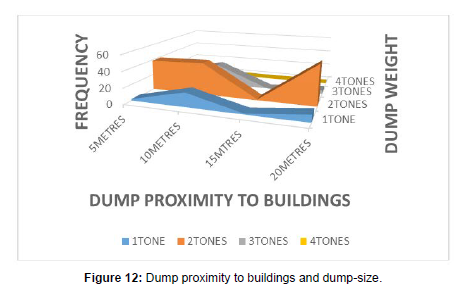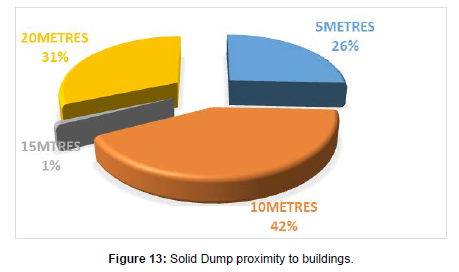The Foraging of Birds on Waste-Dumps in the Campus of Yaounde University II, Centre Region, Cameroon
Received: 14-Aug-2022 / Manuscript No. jee-22-71887 / Editor assigned: 15-Aug-2022 / PreQC No. jee-22-71887(PQ) / Reviewed: 29-Aug-2022 / QC No. jee- 22-71887 / Revised: 01-Sep-2022 / Manuscript No. jee-22-71887(R) / Accepted Date: 08-Sep-2022 / Published Date: 08-Sep-2022 DOI: 10.4172/2157-7625.1000351
Abstract
Foraging of wild birds on city waste dumps is one of the most popular forms of human-wildlife interactions in the world. The extensive bird-habitat destruction for urban development has restricted wild-bird feeding to city wastedumps in most communities in Cameroon. The objective of this study was to examine the importance of waste-dump ecology on wild-bird feeding. The research area was divided into four zones, north, south, east, and west for an effective data collection program. More so, four dumpsites were randomly selected from each zone and were visited twice a week for research data collection. On the dumps, observations were done from 7:00am-6:00pm, and the activities of all the bird species observed were recorded during the period. Additionally, the ecological conditions like the weather changes, photo-period, weight estimate of dumps, proximity of dump to residential homes, major dump materials were recorded simultaneously. The results of the study has shown a positive significant correlation on bird species and dump location r = 0.756, P = 0.000. The study observed a dominant population of Ploceus luteolus 31% and Ploceus cucullatus 31%, compared to Corvus albus 17%, Lonchura fringilloides 17%, and Pycnonotus barbatus 4% on dumpsites. There was a significance between dump location and proximity to buildings X2 = 277.057 df = 9, P = 0.000. The western flank location was richer in waste fragments 31% compared to northern 25%, southern 22% and western flanks 22% respectively. A positive significant correlation was recorded on foraging intensity and bird species X2 = 26.768 df = 8, P = 0.001. There was a significance on weather changes and bird-foraging intensity X2 = 10.221 df = 6, P < 0.05. The sunny weather received the highest foraging activity engagement 52%, compared to wind 24%, cloud 19%, and rain 5% respectively. A positive significance was also witnessed between weather changes and bird-foraging intensity X2 = 10.221 df = 6, P < 0.05. Weather conditions such as heavy rainfall have played a significant role in reducing or halting the foraging activity of wildlife. Waste-dump ecosystem many cities has immensely contributed to the foraging of birds and their population increase. The foraging on available food fragments on waste-dumps has long been a relief strategies in the population increase of wild-city birds. University of Yaoundé II is rich in food subsidies for wild-bird feeding, a situation that has increased the population of wild birds in the university campus.
Keywords: Foraging; Wild-birds; Waste-dumps; Atmospheric Changes; University Campus
Introduction
Humans have altered the ecosystem voluntary and involuntary through the activities performed at global scale. One of the most important current drivers of ecosystem alteration is the predictable anthropogenic food subsidies-food remains produced by humans and exploited by animal species such as birds, especially those derived from rubbish dumps. Solid waste generation is mostly an urban phenomenon and, as urbanization increases, this problem also increases. Indeed, waste volumes are growing faster than urbanization rates and its generation rates will be more than double in the next twenty years, especially in lower income countries. Every day people discard 3 million tonnes of waste around the world, by 2025 the waste generated is expected to be 6 million tonnes per day and by 2100 it will exceed 11 million. Therefore, a peak of waste is expected in the early coming century. In this complex context of waste overproduction, it is expectable that this problem may enhance the ecosystem alteration and lead to a novel ecosystem where changes in biodiversity may occur [1].
Food subsidies derived from rubbish dumps have both positive and negative attributes. On the one hand, they are worldwide distributed, abundant, spatially and temporally predictable, daily renewed and represent a potential valuable food source. Since they are composed of parts of meat, fish, chicken, fresh fruit, meals and eggs, they can be exploited by different species, such as birds and rodents along the food chain and can be used as part of their caloric requirements. On the other hand, however, with these anthropogenic organic items there are also glasses, metals, wire, plastic, paints, different toxics and dangerous pathogens, which can alter individuals’ health and abundances. Therefore, taking advantage of these food subsidies could produce contrasting impacts on vertebrate populations [2].
Many studies around the world document the use of rubbish dumps by bird species. However, there is not much information on the conservation status and population tendencies of species using them. Moreover, there is little information about the health impacts associated to this foraging strategy, survival rates in these sites and the impacts that species using rubbish dumps produce on other species that do not use them. Oro (2013) made a great advance onto this subject, but with a broader focus on different types of food subsidies including food intentionally provided to wildlife. Therefore, a review specifically addressing this topic, focusing in detail on rubbish dumps as food sources, direct and indirect impacts of rubbish dumps on wildlife, and consequences at ecosystem level is timely and necessary [3].
Most studies agree that exploiting these food subsidies produces an improvement in reproductive parameters. For instance, a colony of yellow-legged gulls located near a rubbish dump has a higher population growth probably due to the increase in reproductive success. Yellow-legged and herring gulls had a drop in their breeding performance (clutch size and egg volume) after a dump closure or reduction in organic waste availability. In white storks, breeding success, egg size-hatching mass and clutch size are significantly higher in pairs near rubbish dumps. Moreover, some bird species use waste to provision of their chicks. Approximately 83% of the nestling diet of the laughing gulls (Larus atricilla) is food that comes mainly from rubbish dumps, which enhances the growth and survival of chicks. Similar results are reported for yellow-legged gulls in Spain. Black bears (Ursus americanus) using rubbish dumps have a good reproductive success, and their litter size is above the average. Similar results are described in grizzly bears, for which, in addition, mean cub size declined 17% concurrently with a dump closure. All these studies show that rubbish dumps use and reproductive performance are positively related in different species [4].
This study was focused on examining the value of campus-waste dumps on the feeding ecology of wild birds. The growth of human people in our cities has also created an opportunity for the population of wild birds to increase through waste-dump feeding. However, urbanization has been the major contributor to the destruction of wildlife habitat, consequently some wildlife species like birds have adapted this environmental transformation, fitting themselves and their feeding into the human society through organic waste generation. The campus of Yaounde University II has trees where birds perch and also abundant organic waste dumps for their feeding. Interestingly, the dump-bird-food subsidy seems to have attracted a lot of wild birds from the surrounding campus forest [5].
Materials and Methods
Description of the Study Area
University of Yaoundé II emerged from the former Yaounde University, founded in 1961, and specialized in the teaching and research of social sciences through two branches: Economics, Law and Political Sciences, and Communication and Information Technologies. The university is found at the outskirt of Yaoundé, the capital city of Cameroon, with a student population of nearly 30,000, as well as 316 teachers and 480 administrative staff, it has a high reputation in academic excellence. This campus is situated between latitude 3°7’and 3°9’ N and longitude 11°4’and 11°6’ E (Figure 1). However, Yaoundé city covers over 256 km2 and experiences a typical equatorial climate, with abundant rainfall (1600 mm/year) and an average temperature of 23°C, it has two seasons, the rainy and dry seasons respectively [6].
Methods of Data Collection
The field research started with a pilot study to test the methods to be used in the process. The exercise witnessed adjustment of some variables in the check-sheet not feasible in the field. Hence, the data collection program started in the month of March and ended in July. The research area was divided into four zones, north, south, east, and west. The zonation was based on a sampling method that would reduce bias in the data collection program. Also, four dumpsites were randomly selected from each zone and were visited twice a week for research data collection. On the dumps, observations were done from 7:00am-6:00pm, and the activities of all the bird species observed were recorded during this period. Furthermore, the ecological factors like the weather and photo-period, alongside weight estimate of dumps, proximity of dump to residential homes, major dump materials were recorded simultaneously [7].
Research Data Analysis
The data was analyzed by using Chi-Square (X2) and Correlation (r) statistical models. The inferential and exploratory statistics helped to examine the variables against each other, and to understand their degree of association. The bird species and their activities were examined on dump weight, dump proximity to human residence, and the weather changes.
Results
The results of this study has shown a positive significant correlation on bird species and dump location r = 0.756, P = 0.000 (Figure 2). Solid waste generation and disposal is a human activity that needs good management especially in cities and university campuses congregating human population in large scales. University of Yaoundé II has a hug student population, university office staff, documentation centers and other related businesses. The human activity in the campus generates a lot of solid waste, disposed randomly behind the buildings. The improper disposal of the solid waste materials in the campus has raised a lot of public concern. Poor solid waste disposal and management in these kind of places harboring hug human population makes life uncomfortable. Solid waste in this campus consist of fragments of carbohydrate, meat, fish, plastics, wires, iron, glasses, paper, human feces, flies, rodents, and birds. More so, the waste-dumps release odorous emissions which are very offensive and could be infectious. The study observed a dominant population of Ploceus luteolus 31% and Ploceus cucullatus 31%, compared to Corvus albus 17%, Lonchura fringilloides 17%, and Pycnonotus barbatus 4% on waste-dumps (Figure 3). However, the study only considered the activities of birds on these waste-dumps. Dumpsites have been lucrative feeding sites for birds, insects, rodents, and many other wildlife species in the world. They provide availability of food subsidy to many wildlife species, especially the birds in the campus of University of Yaounde II. Colonies of bird species were observed feeding on the waste-food fragments for survival purpose [8].
There was a significance between waste-dump location and proximity to buildings X2 = 277.057 df = 9, P=0.000 (Figure 4). Waste dumping in this campus is not segregated, hence, the mixture has created a lot of odorous emission problems, especially to neighboring offices and classrooms where you have staff and students. The western flank location was richer in waste fragments 31% compared to northern 25%, southern 22% and western flanks 22% respectively (Figure 5). The northern flank of the campus had more human activities, generating more waste materials, a source of hug bird population activity. Birds were frequently observed flying into the dumpsites whenever the human presence was further, and flying away when it was nearer. Waste-dumps are a feeding source for the wild-bird population in this area especially during the school season. The unavailability of enough food resources in the neighboring bushes to the campus might be the main reason of this hug aggregation of bird population on the campus dumps. Nonetheless, wild birds seem to have adjusted their feeding behavior to adapt to human-dump-food generation through [9].
A positive significant correlation was recorded on foraging intensity and bird species X2 = 26.768 df = 8, P = 0.001 (Figure 6). The survey recorded a high foraging activity of birds 47%, compared to low 29% and normal 24% respectively (Figure 7). Any bird species or colony found on dumpsites had an activity target, foraging on fresh and old waste dumps for metabolism energy purpose. The study noticed a reduced bird-activity output on waste-dumps that never received fresh waste materials either from classrooms, documentation shops and restaurants. Lower bird activity was witnessed whenever they sighted human population nearby. The scarcity of bird-food in nearby bushes could increase their colony population on campus dumps. Unfavorable weather condition has been documented in many studies to slow down the foraging activities of birds and other wildlife species. Heavy snowfall and rainfall are environmental factors that have played the role of pushing some bird species into rest than foraging.
There was a significance on weather changes and bird-foraging intensity X2 = 10.221 df = 6, P < 0.05 (Figure 8). Weather conditions such as heavy rainfall have played a significant role in reducing or halting the foraging activity of wildlife in the wild. The sunny weather received the highest foraging activity engagement 52%, compared to wind 24%, cloud 19%, and rain 5% respectively (Figure 9). The survey witnessed a remarkable bird population and foraging activity reduction during intensive rainfall. Birds flew into nearby bushes and returned to the dumpsites immediately after the rainfall. However, during and immediately after the rain, waste materials such as paper and plastics could no longer be windblown due to their high moisture content. Cameroon experiences heavy rains during some periods of the year, which sometimes flood cities [10].
More so, dominant solid-waste materials and foraging intensity recorded a significance X2 = 6.797 df = 2, P < 0.05 (Figure 10). Some of the solid waste materials in dumpsites are incinerated in order to prevent windblown paper materials littering the school premises. Hence, the management of paper-waste materials on dumpsites might be easier as compared to the plastics and food fragments delivered mainly by campus restaurants. Unfortunately, the inability to segregate solidwaste materials on dumpsites complicates avian dumpsite foraging.
Birds were observed foraging on plastic materials on dumpsites which were not rich in food fragments, a problem that could generate digestion complications. The major solid-waste materials recorded were food 52%, and plastics 48% (Figure 11). Waste dumps rich in food fragments were observed with a hug population of birds [11].
Dump-weight and dump proximity to buildings showed a significance X2 = 26.497 df = 9, P < 0.05 (Figure 12). Dumpsites generate health problems to the human population. Health problems created by waste dumps could be prevented by a proper waste management strategy. Waste-dumps are rich in wildlife species like rodents, snakes, birds, and cats, including domestic animals like cattle, dogs, goats, pigs etc. Additionally, dumpsites are equally rich in insects like flies and mosquitoes, vectors of human diseases like malaria, diarrhea, and typhoid. The human disease infection, as well as environmental pollution role played by dumpsites outsmarts the ecological benefits of bird-foraging. The dominant dump proximity to houses was 10 meters 42% compared to 20 meters 31%, 5meters 26%, and 15 meters 1% respectively (Figure 13) [12].
Discussion
Rubbish dumps are food subsidies for so many wildlife species like birds because of their richness in food fragments (fish, meat, chicken, offal, eggs, seeds, cheese and fruits), which is renewed daily in abundance and can be used by these wildlife species according to natural food availability. For instance, rooks (Corvus frugilegus) highest congregations in rubbish dumps are seen during periods of lowest natural food availability. Similarly, wolves (Canis lupus) eat organic waste when ungulates are not or rarely available, and the peak use of rubbish dumps by grizzly bears (Ursus arctos) and Malayan sun bears coincided with a low availability of high quality natural food. The opposite occurs with spotted hyenas (Crocuta crocuta) in Ethiopia, whose main food source is waste, shifting to donkeys predation when waste availability decreases. Thus, the use of organic waste could be a strategic escape used when natural food is not available or to alternate with other food sources [13].
There are individual differences in organic waste use as food resource according to traits as age, sex, or hierarchical ranking. In bald eagles (Haliaeetus leucocephalus), rubbish dumps may serve as important scavenging sites for hatch-year and second-year eagles, whereas older birds may be more successful obtaining higher quality items in other places. In glaucous gulls (Larus hyperboreus) and white storks (Ciconia ciconia), there is a predominance of juveniles in rubbish dumps. Polar bears that feed in these sites are mainly sub adults and family groups. In grizzly bears, rubbish dumps are first used by males followed by females with cubs and males of herring gulls (Larus argentatus) tended to be dominant over females in a rubbish dump after the opening of an incinerator, which changed the availability of food. Regarding hierarchical ranking, low-ranking females of spotted hyenas are the most common groups feeding at these sites. On the contrary, in grizzly bears social dominant individuals gained access to organic waste while subordinate bears did not. It is clear that depending on the species, the sex-age class and hierarchical ranking, rubbish dumps use could vary producing non-natural imbalances among categories. However, the abundance of each age-sex class in the population will influence the abundance in rubbish dumps; so, this source of bias should be considered to correct estimations of the age-sex structure of a population using dumps [14].
There are several foraging strategies and competitive behaviors among species and individuals associated to rubbish dumps use. Some sub adult individuals can be considered refuse specialists because they are frequently seen feeding in different dumps and the capability of foraging in these sites may take some time. Fighting and stealing food is commonly seen. For instance, black kites (Milvus migrans) and herring gulls (Larus argentatus) conspecifics and other species to acquire food in rubbish dumps. Banded mongoose (Mungos mungo) groups sharing dumps had higher encounter rates than other groups, which can result in increasing fights and competition. Therefore, several species take advantage or develop alternative foraging strategies to withstand the high competition levels with other individuals [15].
Finally, rubbish dumps not only provide organic waste that can be used as food resource for wildlife but also a great number of prey items for different species. Cattle egrets (Bubulcus ibis), for example, feed on flies and fly larvae of the families Muscidae and Calliphoridae, in addition to fish fragments and meat. Bald eagles may also prey upon smaller birds that frequent these places and items like meat and bones. Foxes (Vulpes vulpes) and cats visit rubbish dumps and eat micro mammals like rats. Therefore, several wildlife species congregate near rubbish dumps to exploit other food sources like insects, small mammals, and little birds.
Conclusion
The dumpsites ecosystem in cities have immensely contributed to the foraging of birds and their population increase worldwide. Feeding on available food fragments on dumpsites has long been a food-relief strategy in the population increase of wild-city birds. The bird-weight increase that depend on city-dump feeding as compared to their counterparts in the wild has been due to less energy spent reaching campus dumpsite rich in food fragments. University of Yaoundé II is rich in food subsidies for wild-bird feeding, a situation that has increased the population of wild-birds in the university campus. Unfortunately, the poor management of dumpsites is a common practice in most areas in the country. There is no segregation of waste materials on dumpsites, hence, windblown plastics and papers from dumpsites to human residential buildings is common. Consequently, the management problem of waste materials at dumpsites might be one of the reasons of the prevalence of malaria, typhoid, cholera and other related infections that could be vectored by rodents, insects, and birds into the human society. Malaria and typhoid diseases are very common today in Cameroon probably due to the poor management of dumpsites, a situation aggravated by high living-cost, poverty rate, and unemployment.
Acknowledgement
None
Conflict of Interest
The authors declare no conflict of interest.
References
- Asefa A, Girma M, Tolera S, Yosef M (2019) Local and Landscape-Level Effects of Land Use Change on Bird Diversity in Abiata-Shalla Lakes National Park, Ethiopia. Afr J Ecol 57: 51-58.
- Ayenew (2002) Recent Changes in the Level of Lake Abiyata, Central Main Ethiopian Rift. Hydrol Sci J 47: 493-503.
- Balliett JF (2011) Wetlands: Environmental Issues, Global Perspectives. Angewandte Chemie International Edition 6: 951-952.
- Bekele F, Estifanos S (2018) Challenges to National Park Conservation and Management in Ethiopia.
- Bhatta LD, Sunita CH, Anju P, Himlal B, Partha JD, et al. (2016) Ecosystem Service Changes and Livelihood Impacts in the Maguri-Motapung Wetlands of Assam, India. Land 5: 15.
- Intergovernmental Panel on Climate Change (2007) Climate Change: Impacts, Adaptation and Vulnerability. Cambridge University Press, New York.
- Dechasa F, Feyera S, Dawit D (2019) Determinants of Household Wetland Resources Use and Management Behavior in the Central Rift Valley of Ethiopia. Environ Sustain 2: 355-368.
- Deka S, Om PT, Ashish P (2019) Perception-Based Assessment of Ecosystem Services of Ghagra Pahar Forest of Assam, Northeast India. Geol Ecol Landsc 3: 197-209.
- Elias E, Weldemariam S, Bereket T, Wondwosen G (2019) Impact of Land Use/Cover Changes on Lake Ecosystem of Ethiopia Central Rift Valley. Cogent Food Agric 5.
- Jay IM, Kawaroe M, Effendi H (2018) Lipid and fatty acid composition microalgae Chlorella vulgaris using photo bioreactor and open pond. IOP Conf Ser Earth Environ Sci 141: 012015.
- Gouveia L, Oliveira AC (2009) Micro algae as a raw material for biofuels production. J Ind Microbiol Biotechnol 36: 269-274.
- Liang Y, Sarkany N, Cui Y (2009) Biomass and lipid productivities of Chlorella vulgarisunder autotrophic, heterotrophic and mixotrophic growth conditions. Biotechnol Lett 31: 1043-1049.
- Widjaja A, Chien CC, Ju YH (2009) Study of increasing lipid production from fresh water microalgae Chlorella vulgaris. J Taiwan Inst Chem Eng 40: 13-20.
- Yeh KL, Chang JS, Chen W (2010) Effect of light supply and carbon source on cell growth and cellular composition of a newly isolated microalga Chlorella vulgaris ESP-31. Eng Life Sci 10: 201-208.
- Ru KIT, Sung YY, Jusoh M, Wahid MEA, Nagappan T (2020) Chlorella vulgaris: a perspective on its potential for combining high biomass with high value bioproducts. Appl Phycol 1: 2-11.
Indexed at, Google Scholar , Crossref
Indexed at, Google Scholar , Crossref
J Agric Sci 10: 52-62. Indexed at, Google Scholar , Crossref
Indexed at, Google Scholar , Crossref
Indexed at, Google Scholar , Crossref
Indexed at, Google Scholar , Crossref
Indexed at, Google Scholar , Crossref
Indexed at, Google Scholar , Crossref
Indexed at, Google Scholar , Crossref
Indexed at, Google Scholar , Crossref
Citation: Maurice ME, Junior NJ, Blessing NT, Ebong EL, Moumine NA (2022) The Foraging of Birds on Waste-Dumps in the Campus of Yaounde University II, Centre Region, Cameroon. J Ecosys Ecograph 12: 351. DOI: 10.4172/2157-7625.1000351
Copyright: © 2022 Maurice ME, et al. This is an open-access article distributed under the terms of the Creative Commons Attribution License, which permits unrestricted use, distribution, and reproduction in any medium, provided the original author and source are credited.
Share This Article
Recommended Journals
Open Access Journals
Article Tools
Article Usage
- Total views: 2194
- [From(publication date): 0-2022 - Apr 16, 2025]
- Breakdown by view type
- HTML page views: 1641
- PDF downloads: 553

